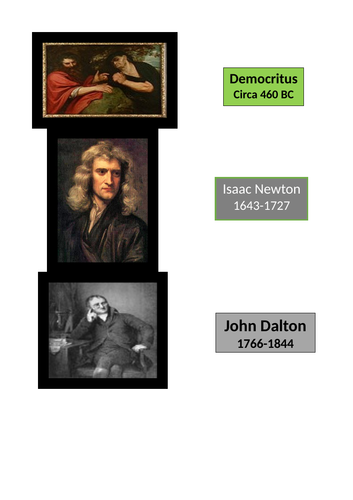




This bundle covers an introduction to atomic theory. In includes a Power Point lesson that includes the topics outline below. It includes a revision or homework page (with answer sheet). A ‘Hot Seat Quiz’ that includes the key terms covered in the lesson and a printable of the key figures in Atomic Theory.
The Power Point lesson covers the key terms:
• Atomic theory
• Atoms
• Atomic structure
• Protons
• Neutrons
• Electrons
• Atomic Mass Unit
This is followed by a section covering describing atoms:
• Electron configuration
• Mass Number (Nucleon number)
• Atomic number (proton number)
The last section covers briefly
• Isotopes
• Relative Mass Unit
• Relative Formula Mass
This lesson cover the section C3 of the iGCSE unit 0653 combined science (some sections regarding the periodic table will be included in a separate section).
C3. Atoms, elements and compounds
3.3 Atomic structure and the Periodic Table
1 Describe the structure of an atom in terms of electrons and a nucleus containing protons and neutrons.
2 Describe the build-up of electrons in ‘shells’ and understand the significance of the noble gas electronic structures and of valency electrons (reference to noble gases not included - this will be in periodic table lesson)
3 State the relative charges and approximate relative masses of protons, neutrons and electrons.
4 Define atomic (proton) number and mass (nucleon) number.
5 Use proton number and the simple structure of atoms to explain the basis of the Periodic Table (see section C9), with special reference to the elements with proton numbers 1 to 20. (not yet included in this section)
In addition, this lesson is combined with the Atomic Theory Timeline. This is not on the IGCSE syllabus however it is a great topic for class research, a mini homework assignment, it can make a nice addition to the course, an introduction to the idea of scientific models or just as an introduction to the periodic table or atomic theory.
This separate PowerPoint contains a lot of detail; thus this Atomic Theory Timeline resource is not really intended to be delivered in the presentation format as like my other lessons. The PowerPoint covers how a theory may change as new evidence is found. How a scientific explanation is conditional but may become more convincing when predictions based on the model or theory are confirmed later on by further ideas/scientific data. It is a good introduction to the concept of models, a brief overview of atoms, a printable of the atomic theory timeline and slides on the models proposed by various key figures in the atomic theory timeline.
Something went wrong, please try again later.
This resource hasn't been reviewed yet
To ensure quality for our reviews, only customers who have purchased this resource can review it
Report this resourceto let us know if it violates our terms and conditions.
Our customer service team will review your report and will be in touch.
